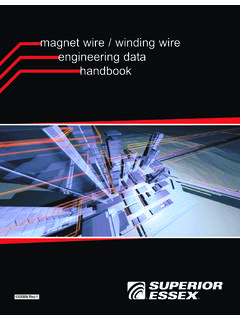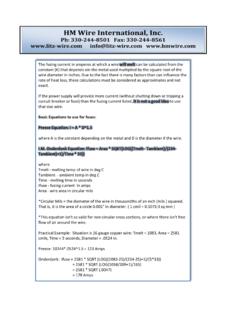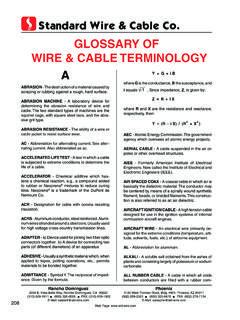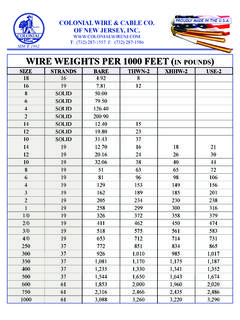Transcription of Capabilities & Limitations Of Laser Marking Wire …
1 10/1/2014 wire and Cable Technology International May/June 2013 : Capabilities & Limitations Of Laser Marking wire wire and Cable Technology International May/June 2013. Change Language: Choose Capabilities & Limitations Of Laser Marking wire by: Brian Peer, and Rick Stevenson Control Micro Systems, Inc. (CMS). 4420A Metric Dr. Winter Park, FL 32792 USA. Of importance is an understanding of the basic interactions between Laser and wire insulation as well as the dynamics of programmable control of the Marking process. Lasers provide both wire manufacturers and OEM end users with a flexible, dynamic, accurate and high-speed Marking solution.
2 When considering a Laser system for Marking wire and cable, it's helpful to understand the basic interactions between Laser and wire insulation as well as the dynamics of programmable control of the Marking process. With a typical wire Laser Marking system, single-core or multiple-strand cable is pulled from a dereeler, fed through the system wire way, passed under the Marking area and then exits through the opposite side to be respooled or collected in a coiling pan (see Figure 1). Laser Marking is accomplished "on-the-fly" as the wire passes through the Marking field with wire transport speeds of up to 600 fpm (actual maximum speed is determined by mark length, mark spacing and Laser power and associated Marking speed).
3 As the wire passes through the Marking field, the Laser beam "draws" the programmed text or image onto the insulation or jacket. With no masks or stencils, the Laser can create any text (using any font) or graphic image including barcodes. Marking Techniques A Laser mark is created by the insulation's absorption of the Laser energy and the subsequent alteration of the polymer to create a legible mark. Legibility can be either a change of color and/or an inscribed line. The degree and type of material change is determined by the duration of exposure to the Laser energy and the percentage of material absorption.
4 The beam-steered Laser Marking system focuses all of the Laser output onto the target wire for maximum efficiency. Interaction of the focused Laser beam with the insulation material induces a desired material effect to create a legible mark. The type of mark is determined by the Marking technique beam-steered Laser Marking uses a small spot size with high energy density, many different techniques are available depending on the insulation material, insulation color, Laser wavelength and the pulse duration (exposure time) of the Laser . Some common Marking techniques are: Photo Chemical Reaction using Short Wavelength (UV) light works in cold process, in which molecular bonds in the insulation are directly broken to produce chemical alteration.
5 A typical example is the reduction of the titanium dioxide in PTFE (Teflon ), ETFE (Tefzel ), XLETFE and FEP, resulting in a dark color change. The depth of this interaction is fairly shallow, typically about 10 to 20 m. As a result of these factors, there's no underlying or surrounding thermal damage to the insulation, which could reduce its protective qualities, even when the insulation is very thin. The UV wavelength is required for all aerospace applications and is usually used on white or light colored wires (see Figure 2). It can not be assumed that cables with the same MIL or SAE specification from two different manufacturers will Laser mark with the same contrast because the exact concentration of TiO2 is not part of the materials can generally be marked with this method in all forms such as dispersion topcoats, extruded polymers and thin tapes.
6 Short wavelength lasers have also been used to mark heat-shrink tubing to create a permanent mark that is visible before and after the tubing has been applied to the wire (see Figure 3). Thermal Bleaching Insulation Color. Surface heat, generated by the Laser beam, bleaches the color from dark pigments to create a contrasting mark. Depth of penetration depends on the insulation material and the fluence of the Laser , but is generally shallow. A related phenomena can be found in the color change of PVC insulations that when affected by the Laser , change to a burnt orange color, regardless of the original color.
7 Laser Marking has become a common enough practice that there are now many suppliers of specialty pigments that are tailored for specific Laser wavelengths. Surface Foaming. Many materials expand when heated by the Laser . As a dark wire insulation expands, the density of 1/3. 10/1/2014 wire and Cable Technology International May/June 2013 : Capabilities & Limitations Of Laser Marking wire the color particles decreases and the material turns a lighter shade of the original, creating a very legible, light of penetration is usually limited to the surface of the insulation.
8 Unlike the other methods, this mark can be felt at the surface. This is a common technique for many dark plastics, but is most robust on harder plastics that cannot be recompressed (see Figure 4). Depending on the polymer, Laser wavelengths from UV to NIR can be used for foaming. Engrave/Melt. When it is not possible to induce a contrasting color change, it may still be possible to create a legible mark by selectively melting the surface of the insulation for an embossed or imprinted appearance. This is often accomplished with a CO2 Laser , which provides the lowest cost per watt of common material processing lasers (see Figure 5).
9 When working with CO2 lasers it must be remembered that comparatively shorter focal lengths are required to achieve line widths necessary on small diameter cables. Laser Selection Lasers are available in a broad spectrum of wavelengths from the ultraviolet through the visible spectrum to the far was shown earlier, choosing the right wavelength for an application is paramount to achieving the correct contrast and permeability, but once the proper Laser wavelength has been determined, the correct Laser must still be chosen. Output configurations span from continuous-wave to high-peak power, short-duration pulsed output.
10 There are also other practical considerations when choosing the Laser such as cost, lifetime, required maintenance, power consumption, etc. The most common Laser sources for wire and cable Marking include the following: Frequency-Tripled Nd:YVO4 or Nd:YAG: 355 nm UV wavelength. Frequency-Doubled Nd:YVO4: 532 nm green wavelength. Ytterbium Fiber: 1060 nm near-infrared wavelength. CO2: 10,640 nm far-infrared wavelength. Chart 1 shows the legibility that is achieved on several common wire insulations using the three solid-state lasers mentioned above. Real-Time Computer Control Programmable, real-time control of the Marking process is a powerful aspect of the wire Laser Marking system.





